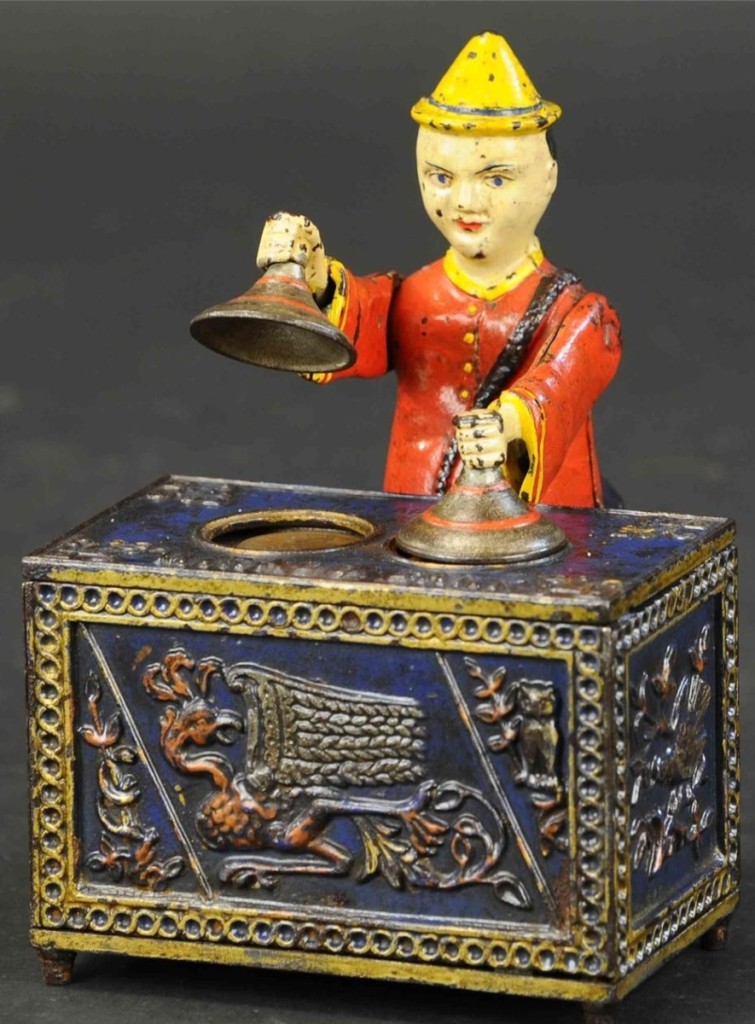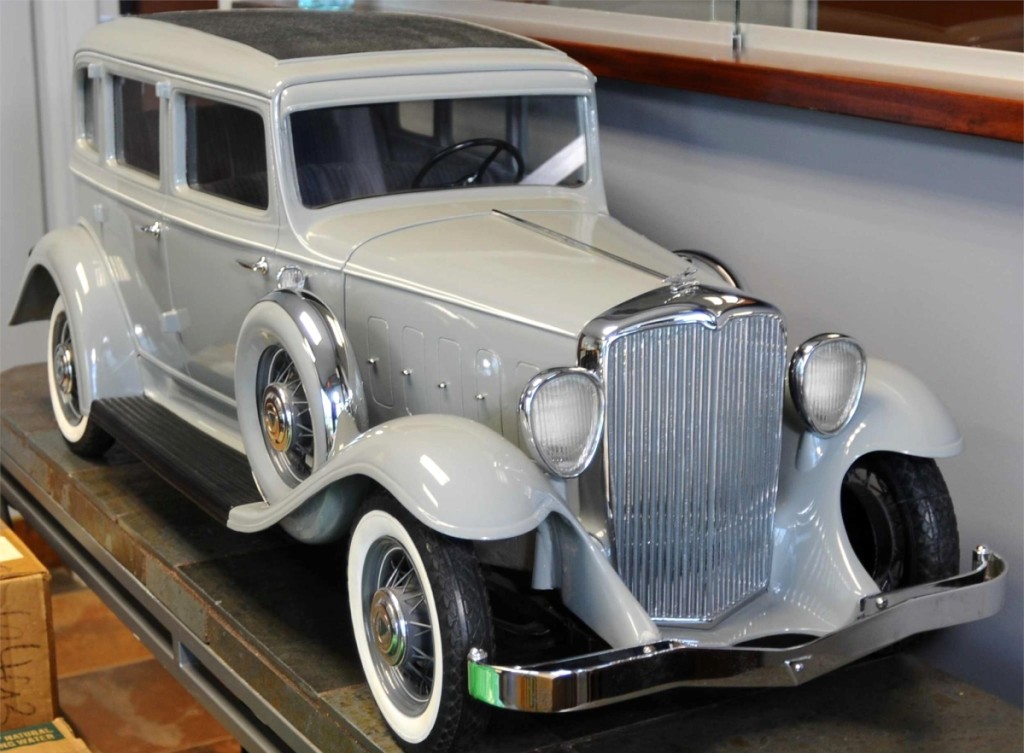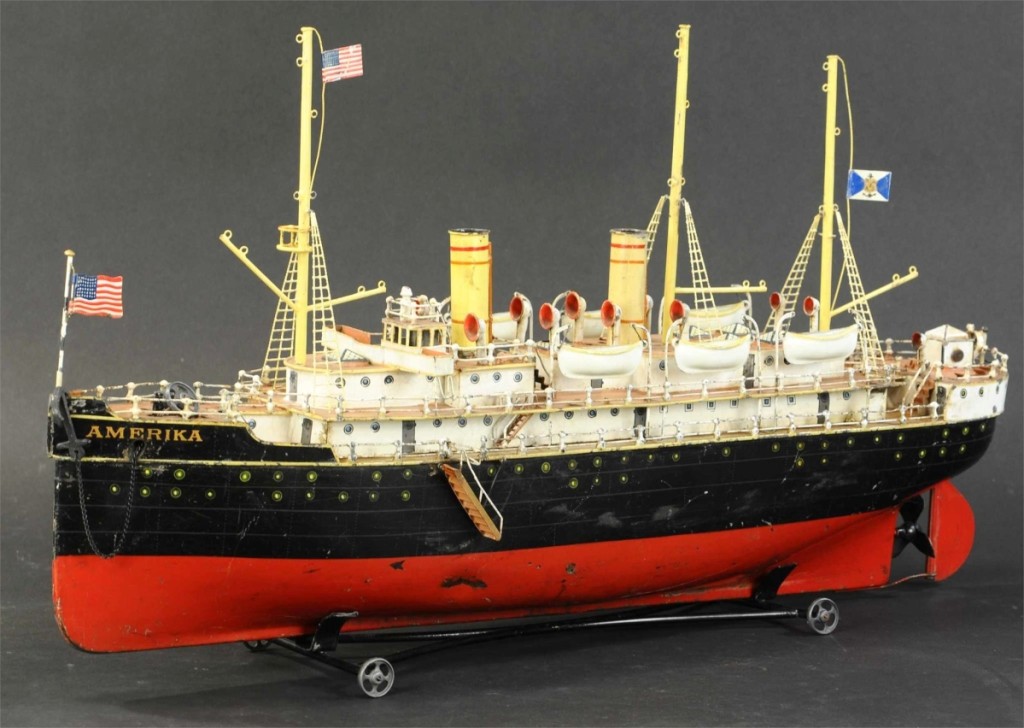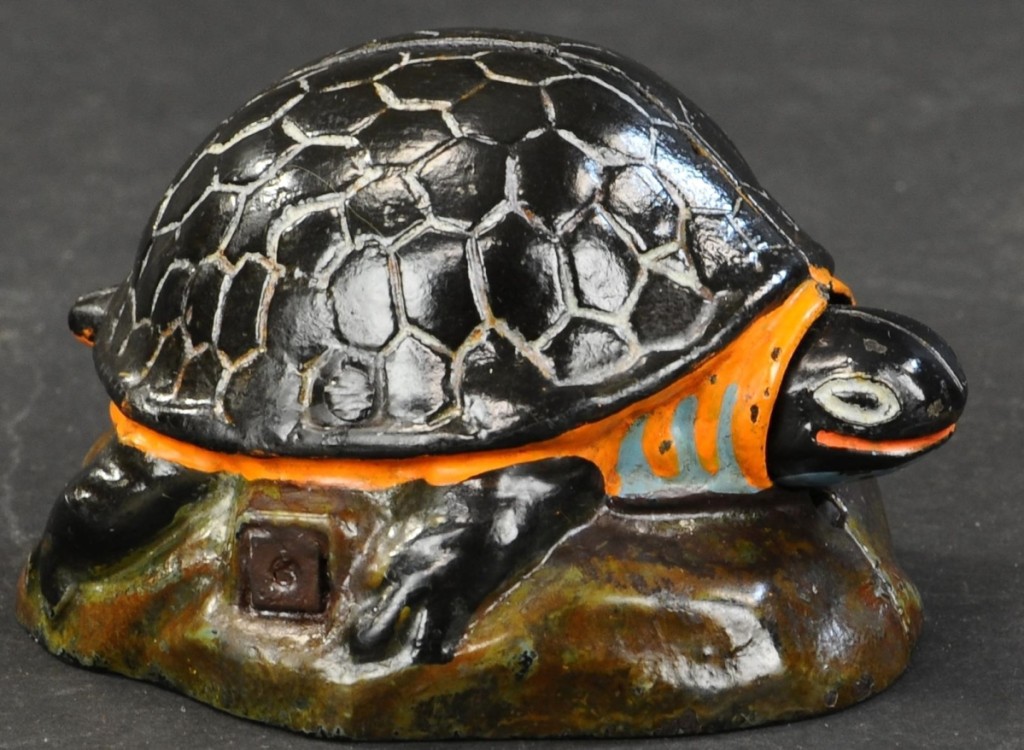
Leading the sale at $45,600 was this Mikado cast iron mechanical bank produced by Kyser & Rex. The bank is in the blue table variant and in nearly all original condition.
Review by Greg Smith, Catalog Photos Courtesy Bertoia Auctions
VINELAND, N.J. – The lead up to Bertoia Auctions’ Signature Sale on May 7-8 was unlike any other, the preceding six weeks best characterized as unprecedented for the auction house and the world at large. Locked down and shut in, principal Jeanne Bertoia said she took time to reconnect with many of her clients and collectors who hail from around the world.
By late-March, the firm had just printed its 239-page full-color catalog and sent it out to its bidder base as it moved forward with the annual two-day spring sale, one of two marquee sale the auction house holds twice per year. She was pleasantly surprised by the collectors’ responses.
“I talked to hundreds of collectors,” she said. “There was a lot of excitement, people had gone through the catalog two or three times cover to cover. It was a nice change for them instead of watching the news.”
She noted that toys, by their very nature, have an inherent sense of escapism and nostalgia.
“In the antique toy world, toys put a smile on people’s faces,” she said. “Toy collectors are, generally, happy. Of course, all collectors are happy to get something, but there’s something special about toy collecting where people reconnect with being a child.”

This 1932 Hudson factory showroom model was reportedly presented at the New York 1932 Auto Show. It measures 46 inches long in restored condition and sold for $28,800.
The sale was a moment of joy in an uncertain time. It was successful by all accounts, settling in at a total gross of $2.5 million.
“It was an extremely strong auction,” Bertoia said. “It had high quality, so we expected the sale to do well and, in spite of the virus, it did great. And because of the virus it had a lot of people at home bidding away.”
The sale was found online on Bertoia Live and Live Auctioneers, with a tremendous amount of absentee bidding and a phone bank that had over ten lines going on certain lots. When the dust settled, there were over 500 successful bidders, with 27 percent of them on Bertoia Live, 24 percent on Live Auctioneers, 32 percent on the phones and 17 percent to absentee.
“I think everybody who collects was just excited and anxious to be able to buy some great quality toys and be entertained,” Bertoia said.
The sale offered seven notable collections that folks were no doubt familiar with. Among them was the first installment of mechanical banks from Bob Weiss, a Schoenhut collection from Charles Foster, cast iron autos from Dmitri Ilyinsky, mechanical banks and doorstops from Bill and Wendy Jones, the Christmas and holiday collection of Karyl Newman, pressed steel toys from Butch Buss and the toy and train collection of Norman Schaut.
Schaut (1932-2019) was well-known in the industry as the promoter of the Atlantique City Antique Show, New Jersey’s largest and longest-running indoor antiques show.

Catching $26,400 was this Marklin live steam Amerika ocean liner, 28 inches long, from the Schaut collection. It had twin funnels, three masts and six life boats.
“Norman loved his trolleys,” Bertoia said, and sure enough a Lionel 2-7/8-inch gauge powered gondola and trailer sold at $40,800. The No. 200 Electric Express Car with original box and track was originally made by Joshua Lionel Cowen to be used in store window displays. Also from this collection came an Ernst Plank Gauge 1, eight-wheel trolley that sold for $22,800. Other standard gauge Lionels would perform well, including $12,000 for a No 101 and $9,600 for a No. 2. All of these were in outstanding condition. Schaut took a liking to Toonerville trolleys, derived from the long-running comic cartoon that originally appeared in the Chicago Post in 1908. Leading the trolleys was a boxed example with train track that sold for $2,700, but even higher was a comic character toy from the series in pristine condition, Eppie Hogg in Auto, that doubled estimate when it sold for $13,200. Bertoia called it one of the most coveted German comic toys.
The sale found remarkably strong interest in Christmas material supplied by the late Lincoln, Neb., collector Karyl Newman, a member of the Golden Glow Christmas collectors club. Her collection was led by an early Belsnickle candy container, 20 inches high, that took $22,800 on a $3,500 estimate. Atop the figure’s head was a crown that served as a candle holder, and Bertoia said she had never seen another form like it.
“She bought very high quality,” Bertoia said. “Much of her collection was in great condition, especially the paper die-cuts and games.”
Nodders did very well, including two large German reindeer. Both were key wound and measured 18 inches high. Each with a $4,500 high estimate and offered in successive lots, both sold to the same collector, the first for $16,800 and the second for $22,800. Coming in at $19,200 was a nodding Santa on a nodding polar bear, which Bertoia said was unusual. Each had its own mechanism.
Two animated displays would perform well against expectations. A die-cut lithographed cardboard animated Santa Claus display, originally produced for a store window, went out at $16,800. It features a scene of Christmas morning as a family gathers around a tree and Santa is distributing presents. A Schoenhut clockwork diorama was touted as the larger of the Schoenhut Christmas living pictures, and it sold for $19,200 on a $9,000 estimate. When the piece was in motion, Santa’s head would pop up in a back window to peak on the children.

From the Bob Weiss collection came this beautifully painted Kilgore Turtle mechanical bank that took $24,000. The example was in pristine condition. When a coin is dropped into the shell, the turtle’s head pokes out.
The sale found its lot leader in a Mikado bank, produced by Kyser & Rex, that sold for $45,600. The bank had the blue table variant and was in excellent condition with original paint except for a minor enhancement to the face of the figure. Bidders climbed on top of one another to get a shot at the Fowler sportsman mechanical bank by J&E Stevens, in pristine condition, that sold for $22,800. It was a single consignment out of Iowa, sold by the grandson of the original owner
Still with cast iron, an Uncle Sam mailbox stand, 58½ inches high, attracted 13 phone bidders as it sold for $8,400 on a $1,200 estimate. Doorstops saw a number of ringers, including a $13,200 result for a football player doorstop with a P on his jersey. Bertoia thought the colors and the letter might indicate it was a University of Pennsylvania player. Behind at $11,400 was a Halloween girl doorstop by Littco Products from the Jones collection. Bertoia said it was one of only four original examples known.
The sale was largely bought by Americans, with only 16 percent of lots selling internationally. Bertoia said the pace was much slower than usual, taking ten hours on the first day and 11 on the second to move through the sessions. Still, she said she was thrilled with the results and said it was a very successful sale.
The next Signature sale is planned for the fall.
All prices reported include buyer’s premium. For information, www.bertoiaauctions.com or 856-692-1881






















